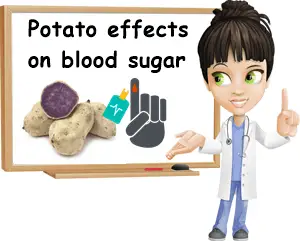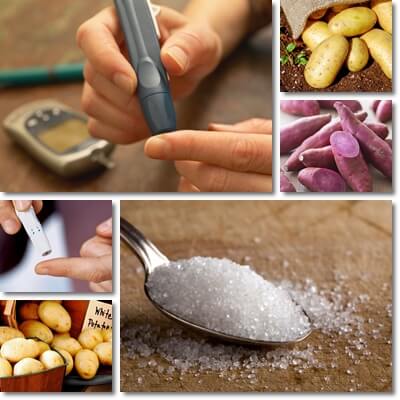If you’re a diabetic and wondering how to include potatoes in your diet without experiencing blood sugar highs and lows, then there are solutions for you. How you eat, cook or pair your potatoes affects their glycemic effects. From limiting your intake to small servings and choosing some potato varieties over others to learning what foods to pair them with for a successful management of blood sugar, you too can include the starchy vegetable in your diet safely and without side effects. Here are 12 great ways to reduce the effects of potatoes on blood sugar for better diabetes management:
1) Not everyday
With regards to potatoes and diabetes, the golden rule is to not eat them every day. Maybe not even every other day. Considering they do not provide benefits specifically for diabetes and have the potential to raise blood sugar levels, they are best consumed infrequently or at least less frequently than other vegetables that are actually good for diabetes (think non-starchy vegetables such as broccoli, cauliflower, spinach, lettuce, arugula, cucumbers, tomatoes, leek, radishes, mushrooms etc., vitamin C-rich and fiber-rich veggies).

2) Small serving size
Potatoes come in all shapes and sizes and it’s not that easy to figure out how much you can eat at once without experiencing spikes in blood sugar levels. But considering they are important sources of carbohydrates and, in the case of sweet potatoes, also simple sugars (that get absorbed quickly and raise blood sugar just as quick), it’s best to limit your intake to small amounts.
To better help you estimate how much or how little you should be having per serving, think about the fact that one small/medium potato with an estimated weight of 170 g gets you up to 30 g of carbohydrates. Of the 30 g, fiber accounts for less than 4 g. In the case of sweet potatoes, you also get 10-16 g of simple sugars (in those 30 g), depending on the type of potato and choice of cooking method. And if you also consider the fact that diabetics are advised to keep their carbohydrate intake to 45-60 g of carbs per meal (3 meals a day), then 1 small/medium potato should be enough, while 2 about cover your entire intake for the meal, if not more.
However, there is no diet that works for everyone and diabetics too respond differently to different foods and different amounts of some foods. With this in mind, consider how a certain food like potatoes affects you individually and adjust your intake based on the effects it has on blood sugar levels in your case. Ideally, go for other veggies for your other meals.

3) Plan your meals ahead
If you are looking to eat potatoes, it’s better to plan your meals in advance. Consider that potatoes are higher-glycemic than other foods due to their more significant carbohydrate content and account for this aspect of their nutrition by choosing the right foods to pair them with as well as adjusting your other meals to account for the carbohydrate intake from the potatoes.
4) Pair with low-carbohydrate, low-glycemic foods
If you’re having a small serving of potatoes, then don’t pair them with other vegetables high in carbohydrates/high-glycemic. Avoid vegetables similar to potatoes (in the sense they raise blood sugar levels): parsnips, pumpkin, squash or corn. Choose low-carbohydrate vegetables instead: leafy greens (spinach, lettuce, arugula, watercress, endives), beets, asparagus, Brussels sprouts, broccoli, cauliflower, celery, cabbage, carrots, cucumbers etc.
5) Pair with light-protein, low-fat foods
Both protein and fat have wonderful benefits for a diabetes, assuming they are consumed in limited amounts, according to the diabetic person’s individual nutritional requirements. One of their benefits for diabetes is their ability to reduce the effects of high-carbohydrate foods on blood sugar metabolism. In other words, if you’re having potatoes, then it helps to have them with a small piece of cheese (30 g), a drizzle of olive oil, some lean chicken meat, a boiled egg and maybe even a teaspoon of home-made mayonnaise or butter. The fat and protein will help lower the rate of sugar absorption into the bloodstream and basically make potatoes more diabetes-friendly. Just don’t lather your potatoes with butter or mayonnaise because that’ll defeat the purpose.
6) Exercise after having carbohydrates
Go for a walk, a bike ride or dance a little around the room. Any form of exercise you engage in right away will be fueled by the carbs in the serving of potato you’ve just had. This helps reduce effects on blood sugar and, long-term, prevent weight gain and diabetes-associated complications (since all excess sugar from high-carbohydrate foods will be deposited in the form of fat and excess body fat fuels diabetes).
7) Baked, roasted or boiled potatoes: which is better for diabetes?
Boiling potatoes breaks down the carbohydrates for easier digestion, but also causes starches (amylose and amylopectin) to bind with water and gelatinize which contributes to a lower glycemic index and, subsequently, a reduced glycemic effect. The reduced effect on blood sugar is more pregnant if the potatoes are allowed to cool down. Baking and roasting use dry heat and lead to the extraction of moisture from the potatoes which, coincidentally, concentrates carbohydrates – which also means that baked or roasted potatoes have a higher glycemic effect compared to boiled potatoes.
And although this is not a popular recommendation for anyone that is the least bit health-conscious, surprise: fried potatoes/French fries actually have a lower glycemic index value! Because of the use of fat to prepare them, their glycemic effects are lowered. However, they remain an unhealthy choice of food because of the fact they are fried (and also because of the use of certain fats for the process) and should not be consumed with regularity. But if you were to enjoy a small serving once in a while, that might not be that bad for your blood sugar.
8) Eat your potatoes cold, not warm
Small scale studies suggest freshly cooked potatoes have a higher glycemic index than day-old, cold potatoes. Cooking (especially boiling) first breaks down the carbohydrates into a more digestible form which allows for a fast digestion and a similarly fast rise in blood sugar levels (what’s digested quickly is absorbed just as quickly). But allowing the cooked potatoes to go cold, especially for a whole day in refrigerator conditions, causes the carbohydrates (mostly starch) to regroup and become more resistant to digestion. This slows down digestion and the rise in blood sugar levels following consumption.
9) Choose waxy potatoes over floury ones
Glycemic index changes with variety as different varieties have different carbohydrate profiles. For example, mealy, floury potatoes intended for frying, baking or roasting (example: Russet) have higher glycemic index scores because they have a higher starch content. Whereas waxy potatoes intended boiling or pureeing have lower glycemic index scores because they have a slightly lower starch content.
On the same note, regular (white, red, purple) potatoes may be slightly better than sweet (these have a significantly higher content of simple sugars which makes them rank high on the glycemic index scale: 70 and higher). However, considering intake should remain limited to small servings, the overall effect on blood glucose metabolism should not be too significant. Also read Can Diabetics Eat Sweet Potatoes?
10) Whole is better than mashed/pureed
Apparently, it’s better to eat potatoes whole or in larger pieces than mashed/pureed. Pureeing potatoes drives their glycemic index up and causes more pregnant effects on blood sugar, especially for diabetics. All purees are like pre-digested food – the form they’re in makes them so much easier to be digested which allows the nutrients in them to be absorbed at a faster rate, including the sugar from carbohydrates. This makes blood sugar go up faster.
11) Slightly undercooked is better
Raw potatoes are so difficult to digest they easily cause stomachaches if eaten as such. This is why we cook them. However, leaving your potatoes just slightly undercooked can make the starch in them more resistant to digestion and contribute to reduced effects on blood sugar (but not by very much, so don’t go filling up your plate).
12) Consider eating the skin
Edible fruit and vegetable skins have fiber, indigestible plant material. And because it’s indigestible, it results in a slower digestion time and a steadier rise in blood sugar levels which is good for diabetes. At the same time, if the potatoes are not organic, then the skin likely retains pesticides so you are better off eating just the flesh, but small servings that don’t generate a too high a rise in blood sugar levels.
